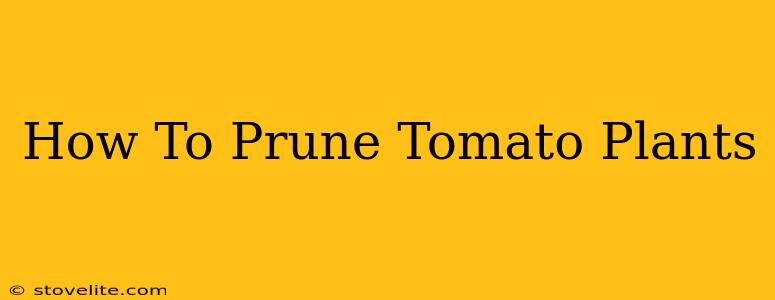Growing tomatoes can be incredibly rewarding, but to get the biggest, juiciest fruits, you need to know how to prune tomato plants effectively. Pruning, or training, your tomato plants isn't just about aesthetics; it's a crucial step in maximizing your yield and keeping your plants healthy. This guide will walk you through the essential techniques for pruning different types of tomato plants, ensuring a bumper harvest this season.
Understanding Tomato Plant Types: The Foundation of Pruning
Before we dive into pruning techniques, it's crucial to understand the two main types of tomato plants: determinate and indeterminate. This distinction significantly impacts how you approach pruning.
Determinate Tomatoes:
- Growth Habit: Determinate tomatoes grow to a certain height and then stop, producing most of their fruit within a relatively short period. They are often referred to as "bush" tomatoes.
- Pruning Needs: Determinate tomatoes generally require minimal pruning. Focus on removing any suckers (small shoots that grow between the main stem and branches) that appear below the first flower cluster. Removing these suckers directs the plant's energy towards fruit production.
Indeterminate Tomatoes:
- Growth Habit: Indeterminate tomatoes continue to grow and produce fruit throughout the growing season, potentially reaching considerable heights. These are the vining types of tomatoes.
- Pruning Needs: Indeterminate tomatoes benefit significantly from pruning. Regular pruning improves air circulation, reduces the risk of disease, and directs energy towards larger fruit. This usually involves removing suckers and sometimes pruning the main stem to control height.
Essential Pruning Techniques: A Step-by-Step Guide
Regardless of the type of tomato plant you're growing, proper pruning techniques are key. Here’s a breakdown of the process:
1. Identifying Suckers:
Suckers are small shoots that grow from the junction where a branch meets the main stem. They compete with the main plant for nutrients, resulting in smaller fruit. Identifying them early is crucial.
2. Removing Suckers:
Use clean, sharp pruning shears or your fingernails to remove suckers. Simply pinch them off at their base, close to the main stem. Avoid leaving any stubs, which can lead to rot. Regularly check for new suckers and remove them as they appear.
3. Pruning for Height Control (Indeterminate Tomatoes):
For indeterminate tomatoes, you can prune the main stem to control the plant’s height and manage its overall size. This is often done by pinching or cutting the top of the main stem. This can be done using a sharp knife or pair of pruning shears. This technique is helpful for easier management and harvesting.
4. Removing Diseased or Damaged Parts:
Throughout the growing season, inspect your tomato plants for any signs of disease or damage. Remove any affected leaves, stems, or branches immediately to prevent the spread of disease.
5. Air Circulation is Key:
Proper pruning improves air circulation within the plant, which reduces the humidity surrounding the leaves and minimizes the risk of fungal diseases, such as late blight.
Tools of the Trade: What You'll Need
- Sharp Pruning Shears or Scissors: Clean, sharp tools prevent the spread of disease.
- Gloves: Protecting your hands from thorns and potential irritants.
- Hand Sanitizer: Keeping your tools and hands clean prevents the spread of diseases between plants.
Frequently Asked Questions (FAQs)
Q: When is the best time to prune tomato plants?
A: The best time to prune is in the early morning or late evening to avoid stressing the plants during the hottest part of the day. Regular pruning throughout the growing season is recommended.
Q: Can I prune my tomato plants too much?
A: While regular pruning is beneficial, you can prune too aggressively. Always leave enough foliage for the plant to photosynthesize and produce energy for fruit development.
Q: What should I do with the pruned suckers?
A: You can simply compost the removed suckers.
By following these steps and understanding the nuances of your specific tomato plant type, you can successfully prune your tomato plants for a bountiful and healthy harvest. Remember, consistent pruning is key to maximizing your yield and enjoying a delicious summer bounty!

